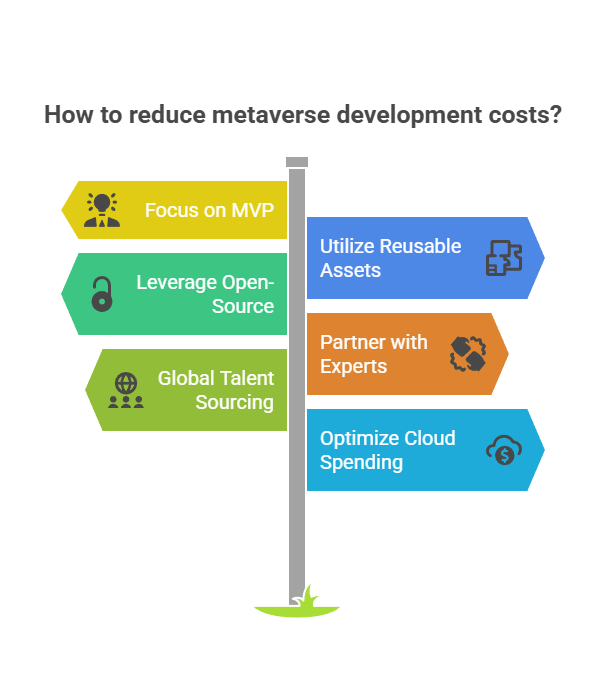The numbers are staggering—estimates show that building a basic 3D multiplayer metaverse for online gaming in 2025 could require an investment of at least $500,000 to $1 million, while a fully-fledged, enterprise-grade social platform might exceed $100 million. That’s not just a cost—it’s a strategic leap into the digital frontier. If your business is contemplating the metaverse, understanding the precise cost to build a metaverse is mission-critical.
Whether your goal is gaming, social interaction, e-commerce, digital real estate, healthcare, or immersive online learning, the budget to create a metaverse platform varies immensely. What drives these investments? How do factors like 3D design, blockchain, server hosting, and ongoing platform maintenance weigh on your virtual world development expenses? Let’s break down the numbers, dispel the jargon, and arm you with insights to make informed decisions—and avoid costly missteps.
What Is a Metaverse?
A persistent, shared virtual environment designed for in-the-moment communication, business, entertainment, and teamwork is the fundamental component of a metaverse. Imagine it as a possible digital counterpart of some features of our real world, but with programmable laws, improved social dynamics, and an infinite amount of creative possibilities that are only constrained by technology and imagination. It’s a step beyond traditional websites or even large multiplayer games, aiming for a deeper sense of presence and shared experience.
There’s a good reason that the cost to build a metaverse is dramatically higher than, say, launching a simple website or mobile app:
- True immersion demands intricate 3D modeling (often needing teams of specialized artists), lifelike avatars capable of nuanced expression, real-time rendering engines that push hardware limits, and often advanced AI to populate the world or personalize experiences. This isn’t just about static graphics; it’s about creating believable, responsive environments.
- Interactivity at Scale means architecting systems capable of handling thousands or even millions of concurrent users seamlessly—across various devices from VR headsets to standard PCs and mobile phones. This involves complex networking solutions and robust backend infrastructure.
- Security and Digital Ownership increasingly rely on blockchain technology, smart contracts for verifiable transactions, and ongoing vigilance to maintain compliance with evolving regulations like GDPR and ensure user data privacy. Trust is paramount, and building it technically is expensive.
Let me explain this further: launching a metaverse is a bit like planning and constructing a city from scratch. Are you building a single interactive venue, a themed district, or an entire interconnected urban sprawl with its own economy? The foundational decisions you make early on regarding scope, technology, and target experience fundamentally set both your trajectory and your ultimate spend.
The 2025 Metaverse App Pricing Breakdown by Industry
How much does it really cost to create a metaverse platform in 2025? The answer depends greatly on your specific industry focus and the depth of your vision. Below, you’ll find a data-driven metaverse app pricing breakdown to help put these potentially enormous figures into perspective, showing the typical ranges observed.
| Industry | Basic (MVP/Limited Features) | Advanced (Rich Features/Scalability) | Enterprise/Immersive (Full Scale/High Fidelity) |
|---|---|---|---|
| Online Gaming | $500k – $1M | $5M – $10M | $10M+ |
| Social Media | $1M – $2M | $50M – $100M | $100M+ |
| Real Estate | $2M – $5M | $20M – $50M | $50M+ |
| E-commerce | $70k – $500k | $500k+ | $500k+ |
| Healthcare | $80k – $1M | $50M – $200M | $200M+ |
| Education | $5M – $30M | $30M – $150M | $150M+ |
 A few observations stand out: social metaverse projects scale dramatically in cost as ambitions move from a basic text-based platform with simple avatars to advanced, feature-rich immersive experiences with sophisticated moderation and user-generated content tools. Similarly, virtual real estate platforms and comprehensive educational metaverses demand enormous capital investment once you aim for city-scale environments, highly detailed simulations, or integration with existing institutional systems. The lower end for e-commerce and healthcare often represents focused tools or virtual showrooms rather than fully independent worlds.
A few observations stand out: social metaverse projects scale dramatically in cost as ambitions move from a basic text-based platform with simple avatars to advanced, feature-rich immersive experiences with sophisticated moderation and user-generated content tools. Similarly, virtual real estate platforms and comprehensive educational metaverses demand enormous capital investment once you aim for city-scale environments, highly detailed simulations, or integration with existing institutional systems. The lower end for e-commerce and healthcare often represents focused tools or virtual showrooms rather than fully independent worlds.
The Anatomy of Metaverse Project Cost Estimate
What really makes up your metaverse project cost estimate? To put it simply, it’s not just about development hours. Here are the main cost layers you’ll need to budget for:
1. 3D Modelling and Design
- Assets Creation: Every avatar, building, and object must be crafted—often by highly specialized artists.
- Environment Rendering: High-resolution visuals demand significant time and technical expertise.
- Animation & Interactivity: Lifelike movements and real-time response increase both complexity and cost.
2. Blockchain Integration and Smart Contracts
- Digital Ownership: Blockchain underpins NFTs (non-fungible tokens) for unique items and land.
- Payment Systems: Secure, transparent value transfer (often using crypto) requires diligent smart contract development.
- Compliance & Security: Ongoing reviews, updates, and security audits are a must.
You might wonder, “Do I need blockchain for my metaverse?” The answer is: if your users will trade, own, or invest in digital goods, it’s essential. For closed environments—think private training grounds—it may be overkill.
3. Server Hosting, Infrastructure, and Scalability
- Cloud Hosting: Robust resources (compute, storage, bandwidth) to handle concurrent users.
- Load Balancing: Smooth performance as user traffic rises and falls—nobody likes lag.
- Maintenance & Updates: Routine upgrades keep your platform reliable and secure.
4. Content Creation and Gameplay Logic
- Scripting: Defines stories, in-game mechanics, or user behaviors.
- AI Integration: Smart NPCs, personalization, or automated moderation raise both utility and cost.
- User Tools: Editors or builder kits empower users (but bump up development needs).
5. Platform Features and Integration
- Social & Communication Tools: Voice, chat, and friend systems.
- Third-party APIs: Integrating payment gateways, AR devices, or existing apps.
- Analytics Dashboards: Tracking engagement and user behavior for continuous improvement.
6. Ongoing Operations and Platform Maintenance
- Bug Fixes & Patches: Like any app, stuff breaks—fast response is key.
- Content Moderation: Preventing abuse and managing digital rights is a 24/7 job.
- Customer Support: Human (or at least responsive) help for your users.

In summary: The bulk of your virtual world development expenses may be invisible to end users, tied up in ongoing work. Don’t overlook this—it’s where true business sustainability lies.
Key Factors Influencing the Cost to Build a Metaverse
So, what specific variables will ultimately determine your project’s final price tag? Understanding these levers is crucial for effective budgeting:
Scope and Complexity
The sheer size and intricacy of your world are primary cost drivers. Are you aiming for a few custom-designed rooms for small meetings, or a sprawling, explorable city with complex economic systems and diverse biomes? Each additional interactive element, unique user role, physics simulation, or intricate gameplay mechanic compounds both development time and required spend significantly. Start simple unless you have deep pockets.
Design Quality and Immersive Experience
- Basic: Utilizing minimalist visuals, mostly static objects, and leveraging template-based assets can keep initial design budgets tighter. This might suffice for functional applications but lack wow factor.
- Premium: Aiming for photo-realistic environments, dynamic weather systems, highly detailed custom avatars with fluid animations, and advanced lighting effects? That’s a fundamentally different (and considerably pricier) undertaking requiring top-tier artistic and technical talent.
User Base and Scalability Needs
Planning for a small, invite-only community initially? Modern cloud-hosted architecture allows you to scale infrastructure somewhat gradually as your user base grows, helping control initial expenses. However, if you’re targeting millions of concurrent users from day one (like a major game launch), you’ll need substantial upfront investment in robust backend engineering, distributed databases, and global server deployment. Concurrency is a major technical challenge.
Security & Compliance Requirements
Particularly crucial for metaverse applications involving e-commerce, financial transactions (DeFi), healthcare data, or children’s interactions, adhering to regulations (like GDPR, HIPAA, KYC/AML, COPPA) isn’t optional, it’s mandatory. Actually, unexpected regulatory changes or new security vulnerabilities can shift development priorities and costs overnight—always budget extra for legal consultation and compliance reviews.
Platform Integrations & Interoperability
Connecting your metaverse seamlessly to existing business tools (like CRMs, ERPs, or marketing automation platforms) or enabling integration with AR/VR hardware and other metaverse platforms widens your potential reach but significantly adds technical complexity—and therefore, cost—due to API development and testing.
Smart Contracts and Blockchain Choice
Choosing the right underlying blockchain (e.g., Ethereum with Layer 2 solutions like Polygon, Solana, Avalanche, or others) is a critical decision with long-term cost implications. Each chain comes with different transaction fees (“gas”), processing speeds, levels of decentralization, development tool maturity, and associated developer talent pool costs. Something often missed by newcomers: migrating complex smart contracts and user assets from one chain to another midstream is exceptionally difficult and expensive, so thorough research upfront is paramount.
Device and Platform Support Strategy
Will users primarily access your virtual world through high-end VR headsets (like Quest, Vive), powerful gaming PCs, standard web browsers, or mobile devices (iOS/Android)? Designing, optimizing, and testing for each distinct platform adds considerable development time and requires careful management of user experience consistency across different input methods and screen sizes.
Step-by-Step: Creating a Realistic Metaverse Project Cost Estimate
Ready to take the plunge and build your own metaverse (or at least get a serious handle on what it might cost)? Here’s a practical, structured approach to estimation:
- Define Your Project Scope and MVP Clearly
- What is the absolute minimum viable product (MVP) needed for a successful initial launch? Be ruthless in prioritizing features.
- Realistically, how many concurrent users are you targeting at launch, 6 months post-launch, and 1 year post-launch? This heavily impacts infrastructure choices.
- What are the core user experiences? List features as must-have, should-have, and nice-to-have for phase 1.
- Break Down Detailed Technical Requirements
- Will you require blockchain for NFTs, token gating, or decentralized governance? Which specific functionalities?
- Are real-time voice/video streaming, AR passthrough, VR-specific interactions, or complex AI-powered features absolutely essential for the MVP?
- What level of graphical fidelity, avatar customization depth, and animation quality is non-negotiable for your brand and target audience?
- Select Your Core Architecture & Technology Stack
- Which game engine is the best fit? (Unity, Unreal Engine, or perhaps a web-based framework like Babylon.js?) Consider available talent pools.
- Will infrastructure be cloud-based (AWS, Azure, GCP), on-premise, or hybrid?
- If using blockchain, which protocol best balances cost, performance, security, and developer ecosystem for your needs?
- Identify Required Personnel and Team Structure
- List the specific roles needed: 3D artists (various specializations), backend engineers, frontend/UI engineers, blockchain developers (if applicable), network engineers.
- Factor in crucial support roles: UI/UX designers, QA testers, project managers, community managers, legal/compliance experts, marketing specialists. Estimate headcount and duration for each role.
- Request Detailed Vendor Quotes or Build an In-House Team Estimate
- If outsourcing, get detailed proposals from multiple reputable agencies with proven metaverse experience. Insist on line-by-line breakdowns, not just a single number.
- If building in-house, estimate salaries, benefits, software licenses, hardware costs, and overhead.
- Crucially, factor in ongoing operational costs (hosting, maintenance, moderation, support) for at least the first 1-2 years post-launch.
- Plan for Contingency and Future Evolution
- Allocate a contingency budget (typically 15-25%) for unforeseen challenges: unexpected technical hurdles, staff turnover, scope creep, market shifts.
- Think about future phases: What major features or platform expansions are planned for year 2 and beyond? Ensure the initial architecture doesn’t preclude future growth.
- Consider potential costs for future hardware compatibility (new VR headsets) or evolving compliance requirements.
A quick, simplified example: Let’s revisit the education provider wanting to launch a virtual classroom metaverse (MVP). Their initial metaverse project cost estimate might break down more granularly like this:
- Phase 1 – Design & Prototyping (3 months): $150,000 (UX/UI design, initial 3D concepts, technical feasibility study)
- Phase 2 – Core Development (6 months): $600,000 (Basic 3D assets, backend infrastructure setup, core interaction logic, simple avatar system)
- Phase 3 – Feature Integration (4 months): $350,000 (Basic content tools, limited blockchain integration for certificates, initial cloud hosting setup)
- Phase 4 – QA, Compliance & Launch Prep (2 months): $100,000 (Testing across devices, security audit, documentation)
- Ongoing Ops (Year 1): $150,000 (Hosting, basic maintenance, minimal support)
- Contingency (15%): ~$200,000
Total Estimated MVP Cost: ~$1,550,000 (This provides more nuance than the previous example)
Real-World Implementation Challenges (and How to Navigate Them)
Creating your metaverse is a strategic, operational, and financial challenge full with possible hazards; it’s not just a technical coding challenge.Here are some subtle, yet common, and sometimes overlooked, challenges businesses frequently encounter:
- Talent Shortages & Costs: It is still challenging and costly to find and keep senior 3D artists (particularly technical artists), experienced blockchain developers, and engineers with knowledge of large-scale real-time systems. This could lead to project delays and a price breakdown for the metaverse app.
- Vendor Reliability & Lock-in:Working with inexperienced or unproven development shops entails serious risks with regard to deadline compliance, security, and quality. On the other hand, an excessive dependence on proprietary systems may restrict future adaptability. The key is due diligence.
- Intellectual Property (IP) and Digital Rights Management: Clear policies and sometimes expensive enforcement procedures are necessary to prevent unlawful use of your own branded content in the metaverse or to manage user-generated content that may violate the intellectual property rights of others (DMCA claims).
- User Safety, Privacy & Moderation:Effectively preventing harassment, scams, false information, and protecting age verification and data privacy, particularly in open, social virtual worlds, necessitates strong, flexible moderation techniques (both automatic and human), which come at a substantial continuous operational cost.
- User Adoption & Monetization Uncertainty:Creating a technically stunning metaverse does not ensure that people will visit, remain, or spend money there. For many ventures, achieving product-market fit, creating an efficient onboarding process, and identifying long-term revenue methods that go beyond initial buzz continue to be major obstacles.

One practical tip gleaned from experience? Strongly consider launching with a focused pilot program, a closed beta, or a limited “land rush” style event. This allows you to rigorously test the core technical mechanics, gather crucial user feedback on the experience, and assess backend stability under real load before committing to a full-scale public launch and marketing blitz. Throwing vast sums of money at developing every conceivable feature on day one rarely yields the best results; iterative development informed by genuine user behavior should guide your evolving priorities and spend.
Cost-Saving Strategies for Metaverse Development
Yes, the potential cost to build a metaverse can feel daunting, particularly for smaller businesses or startups. However, savvy planning, strategic technology choices, and a phased approach can help manage and potentially trim expenses without fatally compromising quality:
- Focus Relentlessly on the MVP: Launch with only the absolute essential features required to deliver core value and test your main hypothesis. Delay non-critical features for later phases based on user data and traction.
- Utilize Reusable Assets & Modular Design: Employ modular 3D components, standardized asset libraries (where appropriate for non-hero elements), and design templates rather than requiring entirely bespoke, unique design for every single object and environment.
- Leverage Open-Source Libraries & Frameworks Wisely: Carefully evaluate and utilize relevant open-source tools and frameworks (e.g., for certain UI components, networking layers) but proceed with caution—ensure they are well-maintained, secure, and won’t create long-term dependency issues or hidden costs. Security must always be thoroughly vetted.
- Partner with Experienced, Specialized Vendors: While potentially having a higher hourly rate, agencies or freelancers who have successfully shipped real-world metaverse products often work more efficiently, make fewer costly mistakes, and provide valuable strategic insights, potentially lowering the total project cost. Look for proven portfolios.
- Consider Global Talent Sourcing Strategically: Tap into distributed development teams across different regions to potentially optimize labor costs, but factor in communication overhead, time zone differences, and the need for strong project management. Quality and reliability should remain paramount over pure cost savings.
- Optimize Cloud Spending: Actively monitor and optimize cloud resource usage. Utilize auto-scaling features effectively, choose appropriate instance types, and leverage reserved instances or savings plans where applicable. Cloud costs can spiral if not managed diligently.

And here’s a less obvious but critical point: sometimes, making a larger investment upfront in robust, scalable infrastructure, thorough security audits, and solid architectural design pays significant dividends down the line. It helps avoid crippling outages, embarrassing data breaches, or the need for expensive, complex refactoring later, which can ultimately cost far more than the initial savings realized by cutting corners. Think long-term value, not just short-term cost.
Frequently Asked Questions about Metaverse Development Cost 2025
Q1: Why does the cost to build a metaverse vary so drastically even within the same industry?
Because “metaverse” is a broad term. Within gaming, for example, a simple social hangout space costs far less than a massively multiplayer online role-playing game (MMORPG) with complex physics and AI. Similarly, a basic virtual storefront differs vastly from a fully simulated digital twin of a manufacturing plant for training. Required features, desired fidelity, scale, security needs, and integration complexity drive the variance.
Q2: How can my company get the most accurate forecast possible for our virtual world development expenses?
Start with extremely detailed project requirements and user stories. Break the project into clear phases with defined deliverables. Request competitive, itemized bids from multiple proven vendors specializing in this space. Engage technical consultants for independent review if needed. Critically, always include a healthy contingency buffer (15-25%) for the inevitable unknowns and changes.
Q3: Is it better to build custom metaverse components or buy/license existing platforms/tools?
It’s a trade-off. If speed-to-market and a lower initial budget are paramount, leveraging existing white-label metaverse platforms or specific licensed tools (like avatar systems) can be a viable shortcut. However, beware of limitations: customization options may be restricted, you’ll be dependent on the vendor’s roadmap, and long-term licensing fees can add up. Full custom builds offer maximum control and unique branding but require more time and capital. Often, a hybrid approach makes sense.
Q4: What’s the biggest hidden cost businesses often overlook when budgeting for a metaverse?
Ongoing operational expenses are frequently underestimated. This includes not just server hosting, but continuous content creation to keep users engaged, robust community management and content moderation (which scales with users), regular security patching and updates, customer support, and evolving compliance requirements. The launch is just the beginning.
Conclusion: Investing Wisely in the Future of Digital Experiences
The race to create the next generation of iconic virtual worlds and immersive digital experiences is already well underway—and businesses that misjudge or underestimate the true cost to build a metaverse risk significant sunk investments, failed projects, or critical missed opportunities. By grounding your strategic plan in a realistic, detailed metaverse project cost estimate, carefully factoring in both the visible upfront development expenses and the often-invisible ongoing operational costs, and thoughtfully navigating the complexities of 3D design, blockchain integration (if needed), scalable infrastructure, and continuous maintenance, your business stands a much stronger chance of successfully staking its claim in the digital frontier.
Remember, building a thriving metaverse is less like a short sprint and more akin to running a marathon that continuously evolves. Break your ambitious vision into manageable stages, maintain a laser focus on operational realities and sustainability from day one, and always prioritize delivering genuine, tangible value to your target users over chasing fleeting technological hype.
Curious about how to tailor a metaverse strategy and budget specifically for your industry and business goals? We’re always here to provide expert strategic guidance. Tap into our world-class expertise in blockchain, AI, and immersive world development, and let’s chart your path into the metaverse—one informed, smart decision at a time.
About Buildfuture
Buildfuture is a global leader in blockchain, AI, and virtual world development, guiding forward-thinking companies from concept to launch—and beyond. Backed by proven expertise and real-world results across diverse industries, we deliver future-proof platforms and strategic insights for businesses seeking to innovate and thrive in the evolving landscape of the metaverse.




